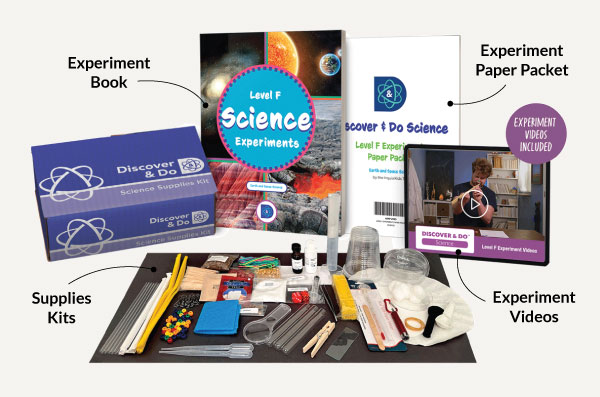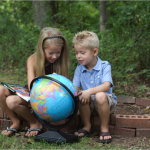Discover fun and engaging hands-on science activities your elementary, middle, or high school student will love—perfect for summer learning fun!

You can make science learning fun. Science education doesn’t have to be limited to textbooks or absrtact theories. You can spark curiosity and even enjoy teaching science by making science learning hands-on. When students can touch, experiment, and discover through direct experience, they develop a genuine appreciation for the scientific principles they’re learning.
What Are Hands-On Science Activities?
Hands-on science activities are interactive learning experiences that encourage students to directly engage with scientific concepts. Essentially, you and your child can apply the concepts learned from books in a practical setting. Instead of memorizing facts or simply reading about chemical reactions.
Hands-on science activities for kids can range from being simple experiments using household materials and starting a home garden to being more complex projects. The key element is active participation; encourage your child to form hypotheses, analyze results, and think critically.
The Benefits of Hands-On Science Activities for Kids
Hands-on science activities are effective for students in many ways, as completing these activities can lead to them to:
- Gaining a better understanding of science concepts. With hands-on learning, your child can connect theoretical or book knowledge to real-world experience. When they see the science in action, kids can develop more lasting comprehension of concepts.
- Developing critical thinking skills. Sonlight’s science curriculum reinforces the importance of the scientific method. Hands-on science activities for kids can achieve the same effect, as your child is encouraged to analyze their results and draw conclusions throughout the project.
- Stimulating creativity. Science is all about exploration and thinking outside of the box to reach a solution or make a breakthrough. Getting hands-on with science can encourage your student to think more creatively when problem-solving or approaching scientific questions.
- Promoting learning as a year-long, lifetime activity. Sonlighters are lifelong learners, and as parents who are raising children with a thirst for knowledge, completing hands-on learning can reinforce a love of discovery.
For high schoolers, these projects can be included in portfolios that they submit with their college admissions applications.
Summer Is the Season to Try Hands-On Science Activities for Kids
The summer break presents unique opportunities to get hands-on with science learning. Without the constraints of rigid academic schedules, homeschoolers have even more flexibility to explore scientific topics and concepts that genuinely interest them.
In addition to having more time, summer is the perfect time to dive into hands-on science activities for kids because:
- It is an ideal time to avoid the "summer slide,” the learning loss that children experience after extended breaks from school. Hands-on science activities provide an engaging way to reinforce and develop academic skills, making them feel more like play than work. So, you can help your child avoid forgetting key concepts while still having fun during your summer vacation.
- Getting hands-on with science during the summer also allows for skill-building in a relaxed environment. With no other schoolwork to do, if your child is interested in a specific topic, they can explore it more freely during the summer.
- Summer science activities can become family adventures that everyone enjoys. Homeschoolers know how rewarding the time you spend learning together can be; get the whole family involved in these activities. With some experiments, you can even make it a competition to see whose hypothesis is right, or break into teams for experiments. Even reluctant readers, and parents, may find themselves having fun!
- Warm weather and longer days create perfect conditions for outdoor scientific fun. Some of the best parts of summer are being outside and enjoying the sun. When you get outside, take some time to incorporate learning.
Easy Hands-On Science Activities for Kids of All Ages
Ready to get your science on this summer? Check out this list of age-appropriate experiments the whole family will enjoy:
Science Activities for Kids in Elementary School
- Colorful erupting volcanoes: If you have baking soda, vinegar, food coloring, and dish soap, you can make a volcano at home. After placing everything but the vinegar into a container (or a paper mache volcano), pour in the vinegar and wait for an eruption.
- Bean plant growth: Grab some dry beans, plastic cups, paper towels, and water; line the cup with a damp paper towel and place the beans between the paper towel and cup. How quickly do you think the beans will grow? Where should you place the cups for the best results? Watch the cups daily and take note of their growth.
- DIY density tower: Ready to see how different liquids form distinct layers in water because of their distinct densities? You will need honey, dish soap, water, vegetable oil, rubbing alcohol, food coloring, and a clear glass. In the cup, add water. Then add the other liquids from heaviest to lightest. What do you notice?
- Weather tracking fun: Using a barometer, notebook, and markers, keep track of the daily temperature, cloud types, and rain patterns. Are there any patterns?
Have a Kindergarten student? Check out this free Level K science experiment from Sonlight. In this free printable science activity, you get to learn all about chocolate!
Science Activities for Kids in Middle School
- Film canister rockets: You will need a film canister with a lid, Alka-Seltzer tablets, and water. We also recommend doing this outside. Add water to the film canister. Then, with the lid in hand, add a tablet (or two) to the canister and quickly cover it. Stand back as it takes flight.
- Homemade lava lamps: If you have vegetable oil, a clear bottle, water, food coloring, and Alka-Seltzer tablets, you can make your own lava lamps. Fill your water bottle with oil. Then add water and food coloring. Finally, add in your tablets and watch as bubbles rise and fall.
- Water quality testing: Get some water test strips or a test kit (available at Home Depot, Ace Hardware, or Amazon). Then, when you visit the beach, the lake, or areas with water, collect some. Alternatively, collect water from sources around your home (e.g., bottled water, sink, etc.) and test its quality.
Science Activities for High Schoolers
- Homemade chromatography: Draw a line with marker on a coffee filter strip, place the bottom in water, and watch the ink separate into colors.
- Robotics projects: Using an Arduino kit, Lego Mindstorms, or other pre-made kits, you can design, build, and program a simple robot.
- Controlled plant growth experiments: Set up multiple plants with one changing factor. Track and measure their growth over time to analyze effects.
Discover & Do Packages: A Great Way to Get Hands-on with Science
Looking for a stress-free way to add hands-on learning this summer? Sonlight's Discover & Do Grade Packages include everything you need to get started—no prep required.
These intentionally designed kits include all the necessary materials, instructions, video guides, and more for 36 experiments and are available for elementary and middle school students. These packages can be purchased as a standalone package but are also included in our larger Sonlight Science Packages for K through middle school levels.






